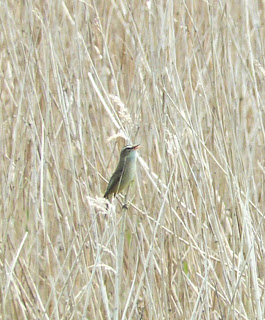Back in the swing of my usual Wednesday walks and we decided to go to one of our favourite venues, Oare. We had a full quorum as Paul was back with us and with lovely sunny weather we were expecting a great day.
 |
| David Bailey eat your heart out! |
Our first encounter was of the audio kind - a rich clear call of cetti's warbler from a willow on the edge of the car park. We have had this welcome many times before and it is a good herald of things to come. Greylag with young, little egret, grey heron, redshank, and black-headed gull were all seen from the car park area, but one of the spots of the day was a yellow wagtail initially seen by Malcolm. The bird was some way off and initially disappeared as the telescope was set up, but eventually it showed well perched on the top of a bush. Later in the day we found a couple more - flitting from tussock to tussock in the fields around the feet of cattle.
 |
| Red Kite |
 |
| Sedge Warbler |
Continuing our journey back to the eastern part of the reserve and linnet were calling, confusing sedge and reed warbler were both calling, but separating them was a challenge - the more we listened the more confused we became. Finally we had a view of both species which confirmed our deductions, but it was quite interesting to realise how uncertain we had become since last year. More homework needed I fear.
Common tern were feeding in front of the hide at the end of Faversham Creek, as we took lunch. Minutes later Malcolm was telling us that Castle Coombe had been known for little tern in the past and it was worth checking for them. With that he took over the telescope and as is often the case when Malcolm issues an edict within minutes he had a potential little tern in view. It flew up the Swale heading right towards us then veering off at the last minute. Malcolm got great views with the telescope from about five miles away - the rest of us had to wait until it came within binocular sight, but then we had a great time watching as it fed with it's distinctive yellow bill and frantic wing flapping. Another great gift from Oare!
 |
| Grey Heron |
Around the East Fleet pochard, a very late wigeon, avocet, moorhen, coot, more greylag families, cormorants all joined in the throng. Some avocet appeared to be on nests whilst others already had young exploring their new surroundings. The highland cattle were panting in the heat and trying to gain as much shelter from the sun as possible, pressing themselves up against the hide. They were not impressed when we opened the flaps and disturbed them.
We finished with a trip to the West Fleet Hide, and on the way nightingale was heard near the stables. As we crossed the field to the hide a group of around 70 starlings - many juveniles - flew around chattering as they moved from tree to tree. Unfortunately we didn't hear the grasshopper warbler which had been reported there, nor did we see little owl, but we had a fantastic day.